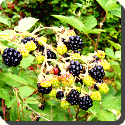 Blackberry — The blackberries (singular, blackberry; genus Rubus, subgenus Eubatus; also called bramble or occasionally “bramble raspberry”) are a widespread and well known group of several hundred species, a number of which are closely related apomictic microspecies, native throughout the temperate Northern Hemisphere.
Blackberry — The blackberries (singular, blackberry; genus Rubus, subgenus Eubatus; also called bramble or occasionally “bramble raspberry”) are a widespread and well known group of several hundred species, a number of which are closely related apomictic microspecies, native throughout the temperate Northern Hemisphere.
They are perennial plants which typically bear biennial stems (“canes”) from the perennial root system. In its first year, a new stem grows vigorously to its full length of 3-6 m, arching or trailing along the ground and bearing large palmately compound leaves with five or seven leaflets; it does not produce any flowers. In its second year, the stem does not grow longer, but the flower buds break to produce flowering laterals, which bear smaller leaves with three or five leaflets. First and second year shoots are usually spiny, usually with numerous short curved very sharp spines (spineless plants also occur). The flowers are produced in late spring and early summer on short racemes on the tips of the flowering laterals. Each flower is about 2-3 cm in diameter with five white or pale pink petals. The newly developed primocane fruiting blackberries flower and fruit on the new growth. The fruit, in botanical terminology, is not a berry, but an aggregate fruit of numerous drupelets ripening to a black or dark purple fruit, the “blackberry”. Unmanaged mature plants form a tangle of dense arching stems, the branches rooting from the node tip when they reach the ground. They are very vigorous, growing at fast rates in woods, scrub, hillsides and hedgerows, covering large areas in a relatively short time. It will tolerate poor soil, and is an early colonist of wasteland and building sites.
The blackberry is known to contain polyphenol antioxidants, naturally occurring chemicals that can upregulate certain beneficial metabolic processes in mammals. It is not advisable to use or eat blackberries growing close to busy roads due to the accumulated toxins from the traffic. The astringent blackberry root is sometimes used in herbal medicine as a treatment for diarrhea and dysentery. The related but smaller European dewberry (R. caesius) can be distinguished by the white, waxy coating on the fruits, which also usually have fewer drupelets. (Rubus caesius) is in its own section (Caesii) within the subgenus Rubus.
 Kids Portal For Parents India Kids Network
Kids Portal For Parents India Kids Network






